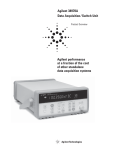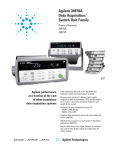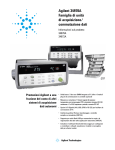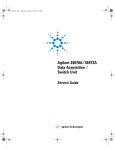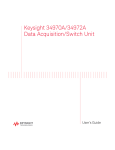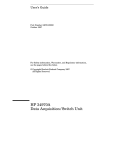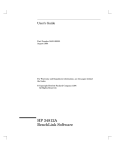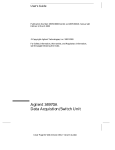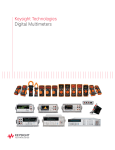Download Agilent Technologies 34970A Specifications
Transcript
Agilent 34970A Data Sheet This document lists specifications for the Agilent Technologies 34970A Data Acquisition/Switch Unit and its modules. The explanations and examples below are helpful in understanding how to interpret these specifications: • Measurement accuracy is specified as percent of reading plus percent of range, where reading is the actual measured value and range is the name of the scale (1V, 10V, etc)—not the full scale value (1.2V, 12V, etc.). • DMM measurement accuracies include all switching errors. Switching errors are also listed separately in the module specifications section. Temperature measurement accuracies include ITS-90 conversion errors. The thermocouple accuracies include the reference junction error as well. • Accuracies are listed as either 24-hour, 90-day, or 1-year specifications. This refers to the length of time since the instrument’s last calibration. Use the specification that matches your calibration cycle. The 24-hour specifications are useful for determining short-term relative performance. EXAMPLE 1: Basic dcV accuracy Calculate the accuracy of the following measurement: 9 V dc input 10 V dc range 1 year accuracy specifications Normal operating temperature (18°C - 28°C) From the following page, the 1-year accuracy is 0.0035% of reading + 0.0005% of range, which translates into (0.0035/100 x 9 V) + (0.0005/100 x 10 V) = 365µV, for a total accuracy of 365 µV / 9 V = 0.0041%. For this example, assume a J-type thermocouple input reading 150°C. From the following page, total error is Thermocouple probe accuracy + 1.0 °C. EXAMPLE 2: Extreme operating temperature The probe vendor specifies accuracy of 1.1°C or 0.4 %, whichever is greater. When the 34970A is used outside of its 18ºC-28ºC temperature range, there are additional temperature drift errors to consider. Assume the same conditions in example 1, but at a 35°C operating temperature: Total error is then 1.0°C + 1.1°C = 2.1°C total, or 1.4%. The basic accuracy is again 0.0035% of reading + 0.0005% of range=365 µV. Now, multiply the 10 V temperature coefficient from the following page by the number of degrees outside of operating range for additional error: (0.0005% reading + 0.0001% range)/°C x (35°C - 28°C) = (0.0005% reading + 0.0001% range)/°C x 7°C = 0.0035% reading + 0.0007% range = 385 µV. Total error is then 365 µV + 385 µV = 750 µV or 0.008%. EXAMPLE 3: Thermocouple measurement accuracy Calculating the total thermocouple reading error is easy with the 34970A— just add the listed measurement accuracy to the accuracy of your transducer. Switching, conversion, and reference junction errors are already included in the measurement specification. EXAMPLE 4: acV accuracy The acV function measures the true RMS value of the input waveform, regardless of waveshape. Listed accuracies assume a sinewave input. To adjust accuracies for non-sinusoids, use the listed crest factor adder. For this example, assume a ±1 V square wave input with 50% duty cycle and a 1 kHz frequency. Accuracy for 1 V, 1 kHz sinusoid is 0.06% reading + 0.04% range. A 50% duty cycle squarewave has a crest factor of Peak Value / RMS value = 1V/1V=1 From Crest Factor table, add 0.05% of reading. The total accuracy is 0.11% of reading + 0.04% of range = 1.5 mV or 0.15%. Accuracy Specifications ±(% of reading + % of range)[1] Includes measurement error, switching error, and transducer conversion error Frequency, etc. Range[3] 24 Hour [2] 23°C ± 1°C 90 Day 23°C ± 5°C 1 Year 23°C ± 5°C Temperature Coefficient 0°C – 18°C 28°C – 55°C 0.0030 + 0.0035 0.0020 + 0.0006 0.0015 + 0.0004 0.0020 + 0.0006 0.0020 + 0.0020 0.0040 + 0.0040 0.0030 + 0.0007 0.0020 + 0.0005 0.0035 + 0.0006 0.0035 + 0.0030 0.0050 + 0.0040 0.0040 + 0.0007 0.0035 + 0.0005 0.0045 + 0.0006 0.0045 + 0.0030 0.0005 + 0.0005 0.0005 + 0.0001 0.0005 + 0.0001 0.0005 + 0.0001 0.0005 + 0.0003 dc Voltage 100.0000 mV 1.000000 V 10.00000 V 100.0000 V 300.000 V True rms ac Voltage[4] 100.0000 mV to 100.0000V 3 Hz - 5 Hz 5 Hz - 10 Hz 10 Hz - 20 kHz 20 kHz - 50 kHz 50 kHz - 100 kHz 100 kHz - 300 kHz[5] 1.00 + 0.03 0.35 + 0.03 0.04 + 0.03 0.10 + 0.05 0.55 + 0.08 4.00 + 0.50 1.00 + 0.04 0.35 + 0.04 0.05 + 0.04 0.11 + 0.05 0.60 + 0.08 4.00 + 0.50 1.00 + 0.04 0.35 + 0.04 0.06 + 0.04 0.12 + 0.05 0.60 + 0.08 4.00 + 0.50 0.100 + 0.004 0.035 + 0.004 0.005 + 0.004 0.011 + 0.005 0.060 + 0.008 0.20 + 0.02 300.0000V 3 Hz - 5 Hz 5 Hz - 10 Hz 10 Hz - 20 kHz 20 kHz - 50 kHz 50 kHz - 100 kHz 100 kHz - 300 kHz[5] 1.00 + 0.05 0.35 + 0.05 0.04 + 0.05 0.10 + 0.10 0.55 + 0.20 4.00 + 1.25 1.00 + 0.08 0.35 + 0.08 0.05 + 0.08 0.11 + 0.12 0.60 + 0.20 4.00 + 1.25 1.00 + 0.08 0.35 + 0.08 0.06 + 0.08 0.12 + 0.12 0.60 + 0.20 4.00 + 1.25 0.100 + 0.008 0.035 + 0.008 0.005 + 0.008 0.011 + 0.012 0.060 + 0.020 0.20 + 0.05 1 mA current source 1 mA 100 µA 10 µA 5.0 µA 500 nA 500 nA/10 MΩ 0.0030 + 0.0035 0.0020 + 0.0006 0.0020 + 0.0005 0.0020 + 0.0005 0.002 + 0.001 0.015 + 0.001 0.300 + 0.010 0.008 + 0.004 0.008 + 0.001 0.008 + 0.001 0.008 + 0.001 0.008 + 0.001 0.020 + 0.001 0.800 + 0.010 0.010 + 0.004 0.010 + 0.001 0.010 + 0.001 0.010 + 0.001 0.010 + 0.001 0.040 + 0.001 0.800 + 0.010 0.0006 + 0.0005 0.0006 + 0.0001 0.0006 + 0.0001 0.0006 + 0.0001 0.0010 + 0.0002 0.0030 + 0.0004 0.1500 + 0.0002 3 Hz - 5 Hz 5 Hz - 10 Hz 10 Hz - 40 Hz 40 Hz - 300 kHz 0.10 0.05 0.03 0.006 0.10 0.05 0.03 0.01 0.10 0.05 0.03 0.01 0.005 0.005 0.001 0.001 Resistance[6] Frequency or Period[7] 100.0000Ω 1.000000 kΩ 10.00000 kΩ 100.0000 kΩ 1.000000 MΩ 10.00000 MΩ 100.0000 MΩ 100 mV to 300 V dc Current (34901A only) 10.00000 mA 100.0000 mA 1.000000 A <0.1 V burden <0.6V <2 V 0.005 + 0.010 0.010 + 0.004 0.050 + 0.006 0.030 + 0.020 0.030 + 0.005 0.080 + 0.010 0.050 + 0.020 0.050 + 0.005 0.100 + 0.010 0.002+ 0.0020 0.002 + 0.0005 0.005 + 0.0010 True rms ac Current (34901A only) 10.00000 mA and[4] 1.000000 A 3 Hz - 5 Hz 5 Hz - 10 Hz 10 Hz - 5 kHz 1.00 + 0.04 0.30 + 0.04 0.10 + 0.04 1.00 + 0.04 0.30 + 0.04 0.10 + 0.04 1.00 + 0.04 0.30 + 0.04 0.10 + 0.04 0.100 + 0.006 0.035 + 0.006 0.015 + 0.006 100.0000 mA[8] 3 Hz - 5 Hz 5 Hz - 10 Hz 10 Hz - 5 kHz 1.00 + 0.5 0.30 + 0.5 0.10 + 0.5 1.00 + 0.5 0.30 + 0.5 0.10 + 0.5 1.00 + 0.5 0.30 + 0.5 0.10 + 0.5 0.100 + 0.06 0.035 + 0.06 0.015 + 0.06 Temperature Thermocouple RTD Thermistor Type 1-Year Accuracy[9] Extended Range 1-Year Accuracy[9] B E J K N R S T -1100°C to 1820°C -150°C to 1000°C -150°C to 1200°C -100°C to 1200°C -100°C to 1300°C -300°C to 1760°C -400°C to 1760°C -100°C to 400°C 1.2°C 1.0°C 1.0°C 1.0°C 1.0°C 1.2°C 1.2°C 1.0°C R0 from 49 Ω to 2.1 kΩ -200°C to 600°C 0.06°C 2.2 k, 5k, 10k -80°C to 150°C 0.08°C [1] Specifications are for 1 hr warm-up and 61/2 digits, Slow ac filter [2] Relative to calibration standards [3] 20% over range on all ranges except 300 Vdc and ac ranges and 1 Adc and ac current ranges [4] For sinewave input > 5% of range. For inputs from 1% to 5% of range and < 50 kHz, add 0.1% of range additional error 2 -400°C to 1100°C -200°C to -150°C -210°C to -150°C -200°C to -100°C -200°C to -100°C -50°C to 300°C -50°C to 400°C -200°C to -100°C 1.8°C 1.5°C 1.2°C 1.5°C 1.5°C 1.8°C 1.8°C 1.5°C Temperature Coefficient 0°C – 18°C, 28°C – 55°C 0.03 °C 0.003°C 0.002°C [5] Typically 30% of reading error at 1 MHz, limited to 1 x 108 V Hz [6] Specifications are for 4- wire ohms function or 2-wire ohms using Scaling to remove the offset. Without scaling, add 1 Ω additional error in 2-wire Ohms function [7] Input > 100 mV. For 10 mV inputs multipy % of reading error x 10 [8] Specified only for inputs >10 mA [9] For total measurement accuracy, add temperature probe error Measurement Characteristics[8] Operating Characteristics[4] DC Voltage Measurement Method: Single Channel Measurement Rates[5] Function Resolution[9] dcV, 2-wire Resistance 61/2 digits (10 plc) 51/2 digits (1 plc) 41/2 digits (0.02 plc) Thermocouple 0.1°C (1 plc) (0.02 plc) RTD, Thermistor 0.01°C (10 plc) 0.1°C (1 plc) 1°C (0.02 plc) acV 61/2 Slow (3 Hz) 61/2 Med (20 Hz) 61/2 Fast (200 Hz) 61/2 [6] Frequency, Period 61/2 digits (1s gate) 51/2 digits (100 ms) 41/2 digits (10 ms) Reading/s 6 (5) 57 (47) 600 57 (47) 220 6 (5) 57 (47) 220 0.14 1 8 100 1 9 70 System Speeds[7] INTO Memory Single Channel dcV 34902A Scanning dcV 34907A Scanning Digital in 34902A Scanning dcV with Scaling & 1 Alarm Fail 34907A Scanning Totalize 34902A Scanning Temperature 34902A Scanning acV[6] 34902A Scanning dcV/Ohms on Alternate Channels 34901A/34908A Scanning dcV ch/s 600 250 250 220 170 160 100 90 60 INTO and OUT of Memory to GPIB or RS-232 (init, fetch) 34902A Scanning dcV 34902A Scanning dcV with Timestamp 180 150 OUT of Memory to GPIB Readings Readings with Timestamp Readings with All Format Options ON 800 450 310 OUT of Memory to RS-232 Readings Readings with Timestamp Readings with All Format Options ON 600 320 230 DIRECT to GPIB or RS-232 Single Channel dcV 34902A Scanning dcV Single Channel MEAS DCV 10 / MEAS DCV 1 Single Channel MEAS DCV/ MEAS OHMS 440 200 25 12 A-D Linearity: Input Resistance: 100 mV, 1 V, 10 V ranges 100V, 300V ranges Input Bias Current: Input Protection: True RMS AC Voltage Measurement Method: Crest Factor: Additional Crest Factor Errors (non-sinewave): Input Impedance: Input Protection: Resistance Measurement Method: Offset Compensation: Maximum Lead Resistance: Input Protection: Continuously Integrating Multi-slope IIIA-D Converter 0.0002% of reading + 0.0001 % of range Selectable 10 MΩ or > 10,000 MΩ 10 MΩ ± 1% < 30 pA at 25°C 300 V all ranges AC coupled True RMS — measures the AC component of the input with up to 300 Vdc of bias on any range Maximum of 5:1 at Full Scale Crest Factor 1-2 0.05 % of reading Crest Factor 2-3 0.15 % of reading Crest Factor 3-4 0.30 % of reading Crest Factor 4-5 0.40 % of reading 1 MΩ ± 2% in parallel with 150 pF 300 Vrms all ranges Selectable 4-wire or 2-wire Ohms Current source referenced to LO input Selectable on 100Ω, 1kΩ, 10kΩ ranges 10% of range per lead for 100 Ω and 1 kΩ ranges. 1 kΩ on all other ranges 300 V on all ranges Frequency and Period Measurement Method: Voltage Ranges: Gate Time: Measurement Timeout: Reciprocal counting technique Same as AC Voltage function 1s, 100 ms, or 10 ms Selectable 3Hz, 20Hz, 200Hz LF limit DC Current Shunt Resistance: Input Protection: 5 Ω for 10 mA, 100 mA; 0.1 Ω for 1 A 1A 250V fuse on the 34901A module True RMS AC Current Measurement Method: Shunt Resistance: Input Protection: Direct coupled to the fuse and shunt. AC coupled True RMS measurement (measures the ac component only) 5 Ω for 10 mA; 0.1 Ω for 100 mA, 1 A 1A 250V fuse on the 34901A module Thermocouple Conversion: Reference Junction Type: Open Thermocouple Check: ITS-90 software compensation Internal, Fixed, or External Selectable per channel. Open >5kΩ Thermistor 44004, 44007, 44006 series RTD α = 0.00385 (DIN) and α = 0.00392 Measurement Noise Rejection 60 (50) Hz[1] dc CMRR: 140 dB ac CMRR: 70 dB Integration Time 200 plc / 3.33s (4s) 100 plc / 1.67s (2s) 20 plc / 333 ms (400 ms) 10 plc / 167 ms (200 ms) 2 plc / 33.3 ms (40 ms) 1 plc / 16.7 ms (20 ms) < 1 plc [1] For 1 KΩ unbalance in LO lead [2] For power line frequency ±0.1% [3] For power line frequency ±1% use 80 dB or ±3% use 60 dB [4] Reading speeds for 60 Hz and (50 Hz) operation [5] For fixed function and range, readings to memory, scaling and alarms off, AZERO OFF [6] Maximum limit with default settling delays defeated [7] Speeds are for 41/2 digits, delay Ø, display off, autozero off. Using 115 kbaud RS-232 setting [8] Isolation voltage (ch - ch, ch - earth) 300 Vdc, ac rms [9] 61/2 digits = 22 bits, 51/2 digits = 18 bits, 41/2 digits = 15 bits Normal Mode Rejection[2] 110 dB [3] 105 dB [3] 100 dB [3] 95 dB [3] 90 dB 60 dB 0 dB 3 System Characteristics Software Scanning Inputs Analog HP BenchLink Data Logger (not included with Option 001) Digital Scan List Scan Triggering Source Scan Count Scan Interval Channel Delay External Trig Delay External Trig Jitter Alarms Analog Inputs Digital Inputs Monitor Channel Alarm Outputs Latency Agilent 34901A, 34902A, and 34908A multiplexer channels 34907A digital in and totalize Scans channels in ascending order Interval, external, button press, software, or on monitor channel alarm 1 to 50,000 or continuous 0 to 99 hours; 1ms step size 0 to 60 seconds per channel; 1 ms step size <2 ms. With monitor on <200 ms <2 ms Hi, Lo, or Hi + Lo evaluated each scan 34907A digital in: maskable pattern match or state change 34907A totalize: Hi limit only Alarm evaluated each reading 4 TTL compatible Selectable TTL logic Hi or Lo on fail 5 ms (typical) System Requirements[2] PC Hardware Operating System Instrument Support Computer Interfaces[3] GPIB LAN -to- GPIB RS-232 (Serial Port) HP BenchLink Features Configuration States Alarm Queue System Features Per-channel Math Power Fail Recovery Relay Maintenance Real Time Clock General Specifications Power Supply Power Line Frequency Power Consumption Operating Environment Storage Environment Weight Safety RFI and ESD Warranty Battery backed, 4 year typical life[1] 50,000 with timestamp Readable during scan 5 instrument states with user label Up to 20 events with channel number, reading, and timestamp Individual Mx + B scaling and Min/Max/Average calculated real time Resumes scanning automatically Counts each relay closure and stores on module User resettable. Battery-backed, 4 year typical life[1] 100V / 120V / 220V / 240V ±10% 45 Hz to 66 Hz automatically sensed 12 W (25 VA peak) Full accuracy for 0°C to 55°C Full accuracy to 80% R.H. at 40°C -40°C to 70°C[1] Net: 3.6 kg (8.0 lbs) Conforms to CSA, UL-1244, IEC 1010 Cat I CISPR 11, IEC 801/2/3/4 3 years [1] Storage at temperatures above 40°C will decrease battery life [2] Software provided on CD-ROM and includes utility to create floppy disks for installation [3] Interface and driver must be purchased and installed separately [4] 90 MHz Pentium, 20 MB RAM [5] Requires VISA command library for IEEE-488 Windows, Windows 95, and Windows NT are registered trademarks of Microsoft Corp. LabVIEW is a registered trademark of National Instruments Corporation. 4 82335B, 82340A/B/C, 82341A/B/C/D National Instruments AT-GPIB/TNT, PCI-GPIB, PC-MCIA E2050A (Windows 95 and NT only) PC COM 1-4 Spreadsheet-like setup page Upload and Download intrument setups Computed channels using _ + - * / , dB, dBm, dBV, x2, √x and full, 1/2, or 1/4 bridge strain Graphical Displays Real-time and historical data displays Add, delete, size, and configure real time Strip chart with markers and alarm indication, X-Y chart with curve fit, Histogram with statistics, Bar meter, Digital meter, and Data table Graphical Controls Sliders, switches, buttons, and LED lights Alarm / Limit Testing Start / Stop scanning on alarm condition Control 34903A relay state or 34907A digital output on alarm Data Real time streamed (saved) to disk Copy data or graphics to windows clipboard Export user-selected data to ASCII file, CSV, TSV Event Logging Automatic entry of alarms and errors Enter user notes real time Printing Setup spreadsheet, all graphics, and event log entries Memory Readings 486, 66 MHz, 16 MB RAM, 12 MB disk space Windows® 3.1,Windows 95®, Windows NT 4.0® Single 34970A operation Single program window HP BenchLink Performance[4] Scan and Save to Disk 100 ch/s 2 strip charts displayed Readings Saved Maximum 150M/file Instrument Driver Support for Programming Languages Universal Compatible with Windows 95 and NT Agilent VEE 3.2 or greater Instrument Driver[5] Visual Basic 4.0, LabWindows CVI 4.0, LabVIEW 4.0 Labview Driver (VI) LabVIEW 4.0 Module Specifications Up to three modules, in any combination, can be inserted into a single mainframe. The 34970A's internal DMM connections are accessible only through the 34901A, 34902A, and 34908A low-frequency multiplexers. The Agilent 34970A accuracy specifications already include the switching offset and reference junction errors shown below. These errors are listed separately for determining system error with external measurement devices. Multiplexer On-module screw terminals accept wire sizes from 16 gage to 22 gage. 20 gage wire is recommended for high channel count applications. The 34905A and 34906A RF Multiplexers use SMB connectors. A standard set of (10) BNC-to-SMB adapter cables is provided with each RF module for convenient BNC connections. Actuator Matrix RF Multiplexer Multifunction 34905A 34906A Dual 1 x 4 50 Ω 75 Ω 34907A See Page 22 for module specifications 34901A 20 + 2 2/4 wire • 60 ch/s 120/s 34902A[1] 16 2/4 wire • 250 ch/s 120/s 34908A 40 1 wire • 60 ch/s 70/s 34903A 20 SPDT 34904A 4x8 2 wire 120/s 120/s 60/s INPUT Voltage (dc, ac rms)[2] Current (dc, ac rms) Power (W, VA) 300V 1A 50W 300V 50mA 2W 300V 1A 50W 300V 1A 50W 300V 1A 50W 42 0.7A 20W DC Characteristics Offset Voltage [3] Initial Closed Channel R [3] Isolation ch-ch, ch-earth < 3uV < 6uV <1Ω <1Ω > 10 G Ω > 10 G Ω < 3uV <1Ω > 10 G Ω < 3uV < 3uV < 0.2 Ω <1Ω > 10 G Ω > 10 G Ω 10 MHz 10 MHz 10 MHz GENERAL Number of Channels Connects to Internal DMM Scanning Speed Open/Close Speed AC Characteristics Bandwidth[4] Insertion Loss (dB) < 6uV < 0.5 Ω >1GΩ 10 MHz 100 MHz 500 MHz 1 GHz 1.5 GHz 2 GHz 2 GHz [5] -0.1 -0.4 -0.6 -1 -1.2 -3 2 GHz [5] -0.1 -0.4 -0.5 -1 -1.5 -2 SWR 10 MHz 100 MHz 500 MHz 1 GHz 1.5 GHz 2 GHz 1.02 1.05 1.20 1.20 1.30 1.40 1.02 1.05 1.25 1.40 1.40 2.00 ch-ch Cross Talk (dB)[4] 10 MHz 100 MHz 500 MHz 1 GHz 1.5 GHz 2 GHz -100 -85 -65 -55 -45 -35 -85 -75 -65 -50 -40 -35 Risetime Signal Delay Capacitance HI - LO LO - Earth Volt-Hertz limit OTHER T/C Cold Junction Accuracy[3] (typical) Switch Life No Load (typical) Rated Load (typical)[7] Temperature Humidity -45 10 MHz -45 -18[6] -45 10 MHz -33 < 50 pF < 80 pF 108 < 50 pF < 80 pF 108 < 50 pF < 80 pF 108 < 10 pF < 80 pF 108 < 50 pF < 80 pF 108 0.8°C 100M 100k 0.8°C 100M 100k 0.8°C 100M 100k 100M 100k 100M 100k Operating Storage (non-condensing) [1] Not recommended for connection to ac line without external transient suppression [2] Channel-to-channel or channel-to-earth [3] Errors included in DMM measurement accuracy specifications [4] 50Ω source, 50Ω load < 300 ps < 3 ns < 20 pF — 1010 5M 100k 5M 100k all cards — 0°C to 55°C all cards — -20°C to 70°C all cards — 40°C / 80% RH [5] Bandwidth direct to card SMB connectors [6] Isolation within channel 1 to 20 or 21 to 40 banks is -40 dB [7] Applies to resistive loads only 5 Multiplexer Selection Guide Choose between the broad functionality of the 34901A, the high speed scanning of the 34902A, or the singleended density of the 34908A. These three modules are the only way to connect to the 34970A internal DMM. They can be used to scan with external instruments as well. All multiplexer modules employ break-before-make scanning, ensuring only one closed channel (or channel pair) at a time. Multiple channel closures are allowed on the 34901A and 34902A modules when not configured for scanning. Number of Channels Max scan speed Number of contacts 34901A 34902A 34908A 20 + 2 60 ch/s 2 or 4 16 250 ch/s 2 or 4 40 60 ch/s 1 • • • • • • • • • • • • • • • • • • • • • • • • Temperature Thermocouple 2-wire RTD 4-wire RTD Thermistor dc Volts ac Volts 2-wire Ohms 4-wire Ohms Frequency Period dc current ac current • • • • • • The 34908A does not allow multiple channel closures at any time. Agilent 34901A 20-Channel General-Purpose Multiplexer • 60 ch/s scanning • Two- and four-wire scanning Backplane Switches Channel Switches H L Internal DMM Input • Built-in thermocouple reference junction The 34901A is the most versatile multiplexer for general purpose scanning. It combines dense, multi-function switching with 60 channel/second scan rates to address a broad spectrum of data acquisition applications. Two- and four-wire channels can be mixed on the same module. Two additional fused inputs (22 channels total) route up to 1A of current to the internal DMM, allowing ac and dc current measurements without the need for external shunt resistors. 6 01 H L 10 H L T • 300 V switching H L H L Reference Junction Sensor H L Internal DMM Input (4W Sense) Com Bank Switch H L Com (4W Sense) 11 H L 20 I L 21 Shunt Switches Fuse I L Internal DMM Input (Current) Current Channels Fuse I L 22 I L Com (Current) Agilent 34902A 16-Channel High-Speed Multiplexer • 250 ch/s scanning • Two- and four-wire scanning • Built-in thermocouple reference junction The 34902A employs reed relays to achieve scan rates up to 250 channels-per-second. Use this module for high-throughput automated test applications as well as high-speed data logging and monitoring tasks. Sixteen two-wire inputs switch up to 300 V. Two- and four-wire channels may be mixed on the same module. User provided shunt resistors are required for current measurements. Backplane Switches H L Internal DMM Input T Channel Switches H L 01 H L 08 H L Com Bank Switch H Com L (4W Sens H L 09 Reference Junction Sensor H L Internal DMM Input (4W Sense) H L 16 Note: Not recommended for connection to ac line without external transient suppression. Agilent 34908A Channel Switches H 01 40-Channel Single-Ended Multiplexer • 60 ch/s scanning • Single-wire switching for commonlow applications • Built-in thermocouple reference junction H 20 H Com Backplane Switch H L Internal DMM Input L Com Bank Switch H 21 Use the 34908A for the greatest density in common-low applications, such as battery test, component characterization, and benchtop testing. Each module switches 40 one-wire inputs. All two-wire internal measurements except current are supported. The module low connection is isolated from earth and can float up to 300V. H 40 T Reference Junction Sensor Note: Thermocouples must be electrically isolated from each other to avoid current loops and subsequent measurement errors. 7 Agilent 34903A 20-Channel Actuator/ General Purpose Switch • SPDT (Form C) latching relays NC • 300 V, 1 A actuation and control COM This general-purpose switch module has 20 independent single-pole, double-throw (SPDT) relays. Use it to cycle power to products under test, control indicator and status lights, and to actuate external power relays and solenoids. Combine it with matrix and multiplexer modules to build custom switch systems. Its 300V, 1A contacts can handle up to 50W, enough for many power line switching applications. Agilent 34904A 4x8 Two-wire Matrix Switch • 32 two-wire crosspoints NC COM 20 NO Col 1 H L Col 2 H L Col 8 H L H Row 1 L • 300V, 1A switching The 34904A gives you the most flexible connection path between your device under test and your test equipment, allowing different instruments to be connected to multiple points on your DUT at the same time. Rows or columns may be connected between multiple modules to build 8x8, 4x16 or larger matrices, with up to 96 crosspoints in a single frame. 01 NO H L Row 2 H Row 3 L H Row 4 L H L H L 8 Channel 31 (Row 3, Column 1) adapters provided with 1 GHz bandwidth. Multiple banks may be cascaded together for applications requiring even larger topologies—create a stubless 16:1 multiplexer in a single frame. Agilent 34905A 50Ω Agilent 34906A 75Ω Dual 4-channel RF Multiplexers • 2 GHz bandwidth • BNC to SMB adapter cables included 11 The 34905A and 34906A RF multiplexers offer broadband switching capabilities for high-frequency and pulsed signals. Use them to route test signals between your device under test and your signal generator, oscilloscope, spectrum analyzer, or other instrumentation. 12 Com 13 14 21 The RF multiplexers are arranged as two independent 1x4 multiplexers, each with a common shield and a switched center conductor. Connections can be made directly to SMB inputs with 2 GHz usable bandwidth, or to the BNC-to-SMB 22 Com 23 24 50Ω MUX Typical AC Performance Graphs Insertion Loss VSWR 0 dB 1.80 -1 dB 1.60 -2 dB 1.40 -3 dB 1.20 -4 dB 1.00 10 MHz 100 MHz 1 GHz 3 GHz 10 MHz Crosstalk -20 dB -40 dB -60 dB -80 dB -100 dB 100 MHz 1 GHz 3 GHz 10 MHz 100 MHz 1 GHz 3 GHz 1 GHz 3 GHz 75Ω MUX Typical AC Performance Graphs Insertion Loss VSWR 0 dB 1.80 -1 dB 1.60 -2 dB 1.40 -3 dB 1.20 -4 dB 1.00 Crosstalk -20 dB -40 dB -60 dB -80 dB 10 MHz 100 MHz 1 GHz 3 GHz 10 MHz -100 dB 100 MHz 1 GHz 3 GHz 10 MHz 100 MHz direct to card using provided adapter cables 9 Agilent 34907A Bit 0 Multifunction Module • 16 bits of digital input and output 8 Port 1 Channel 01 • 100 kHz totalizer input • Two ±12V analog outputs The 34907A allows great flexibility for a variety of sense and control applications. It combines two 8-bit ports of digital input and output, a 100 kHz gated totalizer, and two ±12V analog outputs—all on a single earthreferenced module. The digital inputs and totalizer input may be included in a scan. Alarm limits for the digital and event counter inputs are evaluated continuously, capturing and logging alarm conditions even between scans. DIO Bit 7 Bit 0 8 Port 2 Channel 02 Bit 7 +IN -IN 28 Bits Channel 03 TOT Gate Gate 16 DAC 1 Channel 04 DAC 2 Channel 05 16 Digital Input/Ouput Totalize Input Analog Output Use the digital outputs with an external power supply to control microwave switches and attenuators, solenoids, power relays, indicators, and more. Use the digital inputs to sense limit switch and digital bus status. There are no complex handshake modes; reads and writes are initiated either from the front panel or the bus. Count events from devices like photo interrupters, limit switches, and Hall-effect sensors. Use the two electronically calibrated analog outputs to source bias voltages to your device under test, to control your analog programmable power supplies, or use the outputs as setpoints for your control systems. The outputs are programmed directly in volts, either from the front panel or from the bus. It keeps an updated total which can be read via the front panel or programmatically at any time. With 26 bits of resolution, it can count events at full speed for nearly 11 minutes without an overflow. Analog Output Digital Input/Output Totalize Input Port 1, 2 Vin(L) Vin(H) Vout(L) Vout(H) Vout(H) max Alarming Speed Latency Read/Write Speed 10 8 bit, input or output, nonisolated < 0.8V (TTL) > 2.0V (TTL) < 0.8V @ Iout = - 400 mA > 2.4V @ Iout = 1 mA < 42V with external open drain pull-up Maskable pattern match or state change 4 ms (max) alarm sampling 5 ms (typical) to 34970A alarm output 95/s Max Count Totalize Input Signal level Threshold Gate Input Count Reset Read Speed 226 - 1 100 kHz (max) Rising or falling edge, programmable 1 Vp-p (min) 42 Vpk (max) 0V or TTL, jumper selectable TTL-Hi, TTL-Lo, or none Manual or Read + Reset 85/s9 DAC 1, 2 Resolution IOUT 10 mA max Settling time Accuracy 1 year ±5°C Temp. Coefficient ± 12V, non-isolated 1 mV 1 ms to 0.01% of output ±(% of output + mV) 0.25% + 20 mV ± (0.015% + 1 mV)/°C Rack Mounting and Dimensions 34970A DATA ACQUISITION/SWITCH UNIT To rack mount a single instrument, order adapter kit 5063-9240 (Option 1CM). 34970A DATA ACQUISITION/SWITCH UNIT 34970A DATA ACQUISITION/SWITCH UNIT To rack mount two instruments side-by-side, order lock-link kit 5061-9694 and flange kit 5063-9212. To install one or two instruments in a sliding support shelf, order shelf 5063-9255, and slide kit 14940015 (for single instrument, also order filler panel 5002-3999). 11 Ordering Information Mainframe 34970 Data Acquisition/Switch Unit Includes internal 61/2 digit DMM, Operating and Service Manuals, Test report, power cord, and Quick Start package (includes HP Benchlink Data Logger software, RS-232 Cable, Thermocouple, and screwdriver) Modules are purchased separately and are required to operate. Option 001 Delete Internal DMM Same as above but deletes DMM and quick start package. Order 34970-80010 to retrofit DMM at a later time. Option 1CM Rack Mount Kit Option 0B0 Delete Manual Set Modules 34901A 34902A 34903A 34904A 34905A 34906A 34907A 34908A 20-Channel Armature Multiplexer 16-Channel Reed Multiplexer 20-Channel Actuator/General Purpose Switch 4 x 8 Two-Wire Matrix Switch Dual 4-Channel RF Multiplexer, 50 Ohms Dual 4-Channel RF Multiplexer, 75 Ohms Multifunction Module 40-Channel Single-Ended Multiplexer Our Promise “Our Promise” means your Agilent test and measurement equipment will meet its advertised performance and functionality. When you are choosing new equipment, we will help you with product information, including realistic performance specifications and practical recommendations from experienced test engineers. When you use Agilent equipment, we can verify that it works properly, help with product operation, and provide basic measurement iciently andfor gain competitive edgecapabilassistance thea use of specified ities, at no extra cost upon request. Many self-help tools are available. Accessories 34307A 34308A 34161A 34131A 34397A E2050A 34970-80010 10-pack of J-type thermocouples 5-pack of 10 kΩ thermistors Accessory Pouch Hard Carrying Case (Transit Case) dc-to-ac Inverter LAN/GPIB Gateway DMM Field Installation Kit Fully calibrated with Test Report and Quick Start Kit 34905-60001 Kit of 10 SMB-to-BNC adapter cables, 50Ω 34906-60001 Kit of 10 SMB-to-BNC adapter cables, 75Ω Related Literature Accessories for the Agilent 34970A Data Acquisition/Switch Unit Practical Temperature Measurements Agilent Technologies’ Test and Measurement Support, Services, and Assistance Agilent Technologies aims to maximize the value you receive, while minimizing your risk and problems. We strive to ensure that you get the test and measurement capabilities you paid for and obtain the support you need. Our extensive support resources and services can help you choose the right Agilent products for your applications and apply them successfully. Every instrument and system we sell has a global warranty. Support is available for at least five years beyond the production life of the product. Two concepts underlie Agilent’s overall support policy: “Our Promise” and “Your Advantage.” Pub. Number 5966-4443EUS 5965-7822E Your Advantage “Your Advantage” means that Agilent offers a wide range of additional expert her professional services. test and measurement services, which you can purchase according to your unique technical and business needs. Solve problems eff by contracting with us for calibration, extracost upgrades, out-of-warranty repairs, and on-site education and as well accuracy for the life of training, those products. as design, system integration, project management, and ot Experienced Agilent engineers and technicians worldwide can help you maximize your productivity, optimize the return on investment of your Agilent instruments and systems, and obtain dependable measurement Get assistance with all your test and measurement needs at: www.agilent.com/find/assist Product specifications and descriptions in this document subject to change without notice. Copyright © 1998, 2000 Agilent Technologies Printed in U.S.A. 5/00 5968-2615EN












